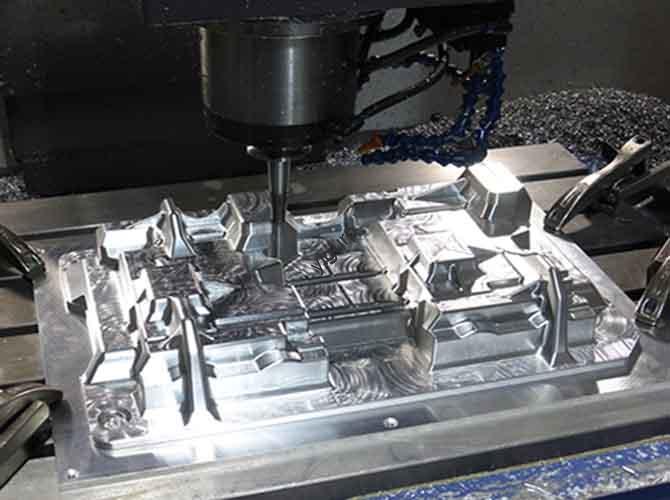Elegir el material adecuado para plastic prototype molds directly impacts the mold’s durability, velocidad de producción, precisión, y costo. There is no “one-size-fits-all” option—materials vary based on project needs like production quantity, Parte complejidad, precision requirements, y presupuesto. This article breaks down the most common materials, sus pros y contras, casos de uso, and a step-by-step guide to select the best fit.
1. Common Materials for Plastic Prototype Molds (Tabla de comparación)
Below is a comprehensive overview of 6 widely used materials, including their key traits and application scenarios:
| Categoría de material | Specific Types | Ventajas clave | Principales desventajas | Escenarios de aplicación ideales |
| Aleación de aluminio | 6061, 7075 | – Ligero (easy to handle) – Excelente maquinabilidad (producción rápida) – Good thermal conductivity (faster cooling for parts) | – Low hardness (wears quickly) – Not suitable for high-volume production | Small/medium-sized prototypes, trial samples, appearance parts (P.EJ., Prototipos de la caja del teléfono) |
| Acero | P20, H13, 45# Acero | – Alta dureza (resistente al desgaste) – Suitable for medium/large molds – A prueba de calor (works with thermoplastics) | – Pesado (hard to transport/operate) – Long processing cycle – Alto costo | Partes funcionales, complex-structure prototypes, high-volume production molds (P.EJ., automotive component molds) |
| Baquelita (Fenólico) | Phenolic resin-based | – Bajo costo (budget-friendly) – Fácil de procesar (fast mold making) | – Baja fuerza (prone to breakage) – Mala resistencia al desgaste – Baja precisión | Baja precisión, pequeño, prototipos no funcionales (P.EJ., simple shape test parts) |
| Epoxy/Polyurethane Resin | Resina epoxídica, poliuretano | – Prototipos rápidos (curado rápido) – Suitable for soft molds – Low cost for small batches | – Baja fuerza (not durable) – Not for high-precision or long-term use | Simple-shape prototypes, exterior parts, temporary molds (P.EJ., short-term trial production molds) |
| Copper/Beryllium Copper Alloy | Cobre puro, cobre de berilio | – Excelente conductividad térmica (fast part cooling) – Good precision retention | – Alto costo (expensive material) – Difficult to process (needs specialized tools) | Piezas de paredes delgadas, componentes de precisión, molds requiring fast cooling (P.EJ., high-precision electronic part molds) |
| 3D Materiales de impresión | Photosensitive resin, nylon | – No traditional machining needed (direct 3D printing) – Ideal for complex shapes – Fast prototyping for small batches | – Limited strength (no resistente al desgaste) – Not suitable for high-volume production | Complex-shape prototypes, small-batch rapid molds (P.EJ., intricate medical device prototype molds) |
2. Key Factors to Consider When Selecting Materials
To avoid 选错 materials (and wasting time/money), follow this 4-step, cause-effect driven guide—each factor directly influences your material choice:
Paso 1: Define Production Quantity
- Lotes pequeños (1–50 partes): Elegir aleación de aluminio, resina epoxídica, o 3D Materiales de impresión (producción rápida, bajo costo).
- Lotes grandes (500+ regiones): Optar por acero (resistente al desgaste, durable enough for repeated use).
- Lotes medianos (50–500 partes): Balance with aleación de aluminio (if precision needs are moderate) o low-cost steel (if durability is critical).
Paso 2: Assess Precision Requirements
- Alta precisión (±0.01mm or tighter): Usar acero (stable dimension retention) o copper/beryllium copper alloy (excellent precision for small parts).
- Moderate precision (± 0.1 mm): Aleación de aluminio o 3D printing with photosensitive resin Funciona bien.
- Baja precisión (± 1 mm): Baquelita o resina epoxídica is sufficient (budget-friendly).
Paso 3: Evaluate Budget Constraints
- Bajo presupuesto: Priorizar bakelite, resina epoxídica, o entry-level 3D printing materials (nylon/PLA-based).
- Medium budget: Aleación de aluminio (balances cost and performance) es la mejor opción.
- Alto presupuesto: Comprar acero (por durabilidad) o beryllium copper alloy (for high precision and cooling speed).
Paso 4: Analyze Part Complexity
- Formas complejas (P.EJ., internal hollows, Detalles finos): 3D Materiales de impresión (no need for traditional machining) o aleación de aluminio (easy to mill complex features).
- Formas simples (P.EJ., paneles planos, basic frames): Baquelita, resina epoxídica, o low-cost steel (fast processing, no extra complexity).
3. La perspectiva de la tecnología de Yigu
En la tecnología yigu, we believe plastic prototype mold material selection is a “balance of needs” rather than chasing a single “best material.” For most clients—especially startups and small businesses—aleación de aluminio (6061) is the most versatile choice: it’s fast to machine, rentable, and precise enough for 80% of prototype needs. Para proyectos de alta precisión (P.EJ., Prototipos de dispositivos médicos), Recomendamos beryllium copper alloy for its cooling speed and precision retention. For budget-limited, simple tests, 3D printed photosensitive resin molds cut lead time by 50% compared to traditional materials. Nuestro consejo: Start by listing your top 2 priorities (P.EJ., “speed + low cost” or “precision + durability”)—this narrows down materials in minutes.
4. Preguntas frecuentes (Preguntas frecuentes)
- q: Can I use 3D printing materials for plastic prototype molds that need to produce 100 regiones?
A: Depende del material. Photosensitive resin molds are only suitable for 10–20 parts (low wear resistance), pero nylon-based 3D printing materials can handle 50–80 parts. Para 100 regiones, Recomendamos aleación de aluminio (more durable and cost-effective).
- q: Is steel always better than aluminum alloy for plastic prototype molds?
A: No. Steel is better for high-volume, high-wear scenarios, but aluminum alloy is superior for small batches: it’s 3x faster to machine, 1/3 the weight, y 50% más económico. Choose steel only if you need 500+ parts or extreme durability.
- q: Why is beryllium copper alloy used for thin-walled plastic parts?
A: Es Excelente conductividad térmica (2x higher than aluminum) ensures thin-walled parts cool quickly and evenly, reducing warping or deformation. This is critical for thin parts (P.EJ., 0.5mm thick electronic casings) where shape accuracy is key.
